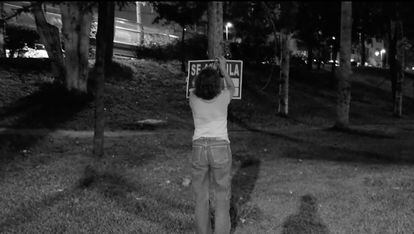“It is easier to imagine the end of the world than the end of capitalism”: the phrase is sometimes attributed to Slavoj Žižek and sometimes to Fredric Jameson, and is the starting point of curator Valentín Roma to organize this brief, but lucid and inspiring. More than a thesis statement, it is an expository essay designed to refute the little phrase in question. Not so many years ago, the brilliance of his fatalistic sarcasm might have been refreshing. But at this point, when the crises of the system (environmental, migratory, informational, lack of control of bioengineering or supercomputing) are no longer threatening possibilities but pressing realities, it sounds hackneyed and, above all, it sounds false. What Roma remembers, through the example of the work of seven artists and groups, is that contemporary art of late capitalism has dedicated itself to imagining precisely its alternatives or its system failures. And that many theorists of dissidence would benefit from visiting museums more often and thinking about art to renew its language and methods.
Because the second quote that articulates the exhibition are verses by Adrienne Rich: “The knowledge of the oppressor / is the language of the oppressor / and yet I need it to speak to you.” Rome is interested in artists who not only fantasize about the end of capitalism, but also appropriate its codes (legal structures, financial jargons, market values) to sabotage them from inside, introducing in them “a speech that invokes discrepancy and vulnerability, a dialect that opposes the volatile and unappropriable power of poetry.” In this way, the supposed capitalist realism, its overwhelming common sense that paradoxically leads to nonsense, is revealed, in the end, as one more fable among many others imaginable and practicable.
And speaking of poetry, there is (and a lot of it, in its variant of poetic justice) the very place where the works are: in the depths of the gloomiest basements of the old Conde Duque barracks, embedded in the center of Madrid like symbol of the wavering power of a nation-state that was already at its lowest point at that time. Because this is a concise and chamber exhibition, yes, but a vault. If the damp brick vaults represent the heart of power, it turns out that artists deciphered the access passwords a long time ago. To paraphrase Marta Peirano, the enemies of the enemy also know the system.
Artists not only fantasize about the end of capitalism, but they appropriate its codes to sabotage them from within
And they hack it in very different ways: Esther García Llovet, who reveals in her books the ghostly, poetic and deranged B-side of the crazy world in which we move without thinking, debuts as a video artist with a short piece that, right from the title, Smarter than Idealist, defends a kind of white-glove hooliganism as elegant and accurate as that of his prose. He walks through the night at the rhythm of techno minimalist the Madrid M-30, that border/moat of class and control, looking for its blind spots to ironize the real estate speculation of the deranged and border Madrid that he knows so well and uses as an allegory.
At the antipodes are the solemn and thoughtful diagrams on partitocracy or direct democracy that Joseph Beuys put together for Documenta in 1972… or perhaps not so far away, because the performance/fantasy of his boxing match between both systems (he was the direct one) remind us that the great guru/charlatan/thaumaturge of art of the 20th century also adulterated his analyzes of power with invention, poetry, and even the great hoaxes and trolling. The pieces by Cuban Marco A. Castillo, co-founder of Los Carpinteros, are made of a drier, almost incomprehensible sense of pure sibylline humor. Particularly its recreation in meticulously turned (and subtly encrypted) wood of the latticework of the purest formal and revolutionary Cuban modernism: it served as a background in the Protocol Hall of the Council of State in Havana for many televised addresses by Fidel at the summit of its power: a figure as elusive and ambiguous as this piece.

And along with classics such as the video pieces by Barbara Hammer or Alexander Kluge, the vast project stands out Black Book, by Max de Esteban, which dissects for the uninitiated the perfectly legal procedures to carry out to create companies in tax havens. It includes an animated film, photographic panels and a constellation of references on a table where childhood comics and table trophies are mixed as a reward for his work in his previous job as an executive for large corporations. Cartoons and trading cards, yes, are also combat tools when handled by a insider. They reminded me of the gigantic diagrams full of arrows and balloons that Mark Lombardi exposed starting in 1994. They showed very clearly the global financial and political plots and scandals of the nineties, such as that of the Vatican Bank or the Kashoggi scheme.
Lombardi had begun drawing them to clarify himself while speaking as a researcher on the phone with one of his informants, and they ended up in the collections of the MoMA or the Whitney. A few weeks after 9/11, and a year after his suicide, the FBI officially asked the Whitney to consult his mural about the relationships of the Bush and Bin Laden families: it could contain vital clues about the reasons for the attack. . If even an intelligence agent of a world superpower needs to see a work of art to orient himself in his investigation, all may not be lost nor may the works and ideas in this exhibition be so misguided.
'The great fable of capital'. Count Duke. Madrid. Until april 14th.
You can follow BABELIA on Facebook and xor sign up here to receive our weekly newsletter.
Subscribe to continue reading
Read without limits
_
#Art #late #capitalism #enemies #system